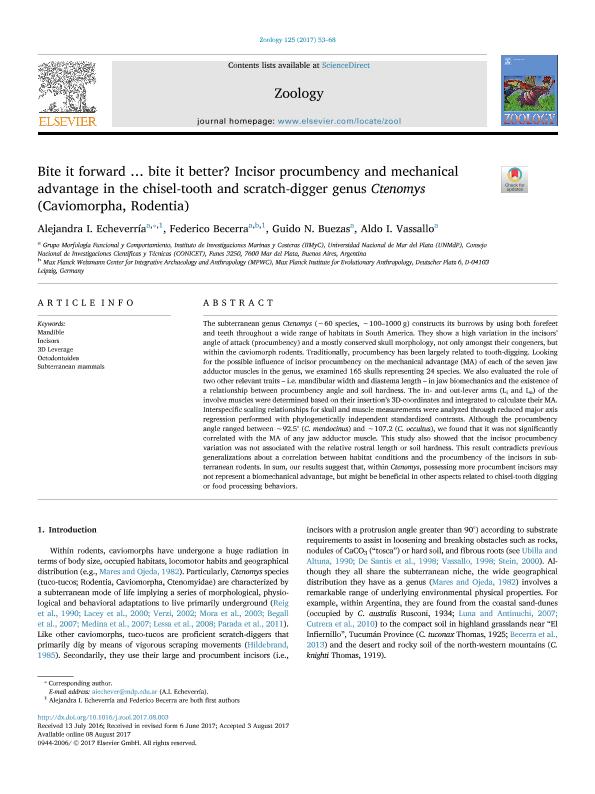Artículo
Bite it forward … bite it better? Incisor procumbency and mechanical advantage in the chisel-tooth and scratch-digger genus Ctenomys (Caviomorpha, Rodentia)
Fecha de publicación:
12/2017
Editorial:
Elsevier Gmbh
Revista:
Zoology
ISSN:
0944-2006
Idioma:
Inglés
Tipo de recurso:
Artículo publicado
Clasificación temática:
Resumen
The subterranean genus Ctenomys (∼60 species, ∼100–1000 g) constructs its burrows by using both forefeet and teeth throughout a wide range of habitats in South America. They show a high variation in the incisors’ angle of attack (procumbency) and a mostly conserved skull morphology, not only amongst their congeners, but within the caviomorph rodents. Traditionally, procumbency has been largely related to tooth-digging. Looking for the possible influence of incisor procumbency on the mechanical advantage (MA) of each of the seven jaw adductor muscles in the genus, we examined 165 skulls representing 24 species. We also evaluated the role of two other relevant traits – i.e. mandibular width and diastema length – in jaw biomechanics and the existence of a relationship between procumbency angle and soil hardness. The in- and out-lever arms (Li and Lo) of the involve muscles were determined based on their insertion's 3D-coordinates and integrated to calculate their MA. Interspecific scaling relationships for skull and muscle measurements were analyzed through reduced major axis regression performed with phylogenetically independent standardized contrasts. Although the procumbency angle ranged between ∼92.5° (C. mendocinus) and ∼107.2 (C. occultus), we found that it was not significantly correlated with the MA of any jaw adductor muscle. This study also showed that the incisor procumbency variation was not associated with the relative rostral length or soil hardness. This result contradicts previous generalizations about a correlation between habitat conditions and the procumbency of the incisors in subterranean rodents. In sum, our results suggest that, within Ctenomys, possessing more procumbent incisors may not represent a biomechanical advantage, but might be beneficial in other aspects related to chisel-tooth digging or food processing behaviors.
Palabras clave:
3D LEVERAGE
,
INCISORS
,
MANDIBLE
,
OCTODONTOIDEA
,
SUBTERRANEAN MAMMALS
Archivos asociados
Licencia
Identificadores
Colecciones
Articulos(IIMYC)
Articulos de INSTITUTO DE INVESTIGACIONES MARINAS Y COSTERAS
Articulos de INSTITUTO DE INVESTIGACIONES MARINAS Y COSTERAS
Citación
Echeverría, Alejandra Isabel; Becerra, Federico; Buezas, Guido Nicolás; Vassallo, Aldo Iván; Bite it forward … bite it better? Incisor procumbency and mechanical advantage in the chisel-tooth and scratch-digger genus Ctenomys (Caviomorpha, Rodentia); Elsevier Gmbh; Zoology; 125; 12-2017; 53-68
Compartir
Altmétricas




